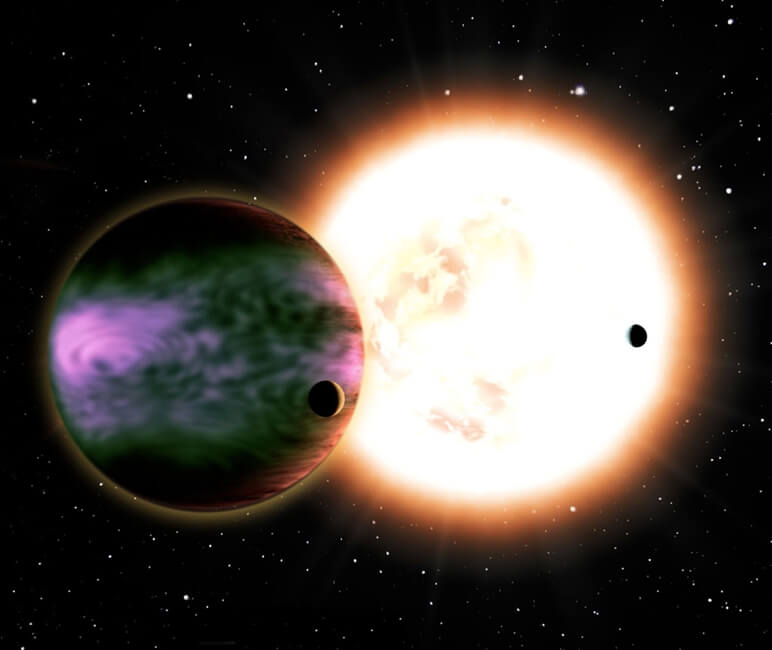"I would be happy to join an observation tour of these polar lights," says Ofer Cohen from the Harvard-Smithsonian Institute for Astrophysics in Cambridge, Massachusetts, who calculated the intensity of the phenomenon
Researchers have shown that the auroral auroras of hot Jupiters may be much brighter than initially thought.
Harvard Smithsonian Center for Astrophysics, Cambridge Massachusetts

The northern and southern polar auroras on Earth provide a light show for people living in the polar regions. Glowing green and red curtains dance across the sky like living creatures. Now new research shows that the auroras in stars outside the solar system, known as hot Jupiters, can be 100 to 1,000 times brighter than the auroras of Earth's poles. They will also extend from the equator to the poles due to the planet's close proximity to any solar flare, which turns the entire planet into a spectacular light show.
"I would be happy to join an observation tour of these polar lights," says Ofer Cohen from the Harvard-Smithsonian Institute for Astrophysics in Cambridge, Massachusetts.
The aurora borealis on Earth is created when energetic particles from the Sun collide with Earth's magnetic field. The field guides the particles from the sun toward the poles, where they collide with the Earth's atmosphere, causing the air molecules to glow in fluorescent colors. A similar process may also happen around stars orbiting distant suns.
A particularly strong aurora occurs when the Earth is hit by a massive mass ejection in solar storms - a huge eruption that launches billions of tons of solar plasma (hot ionized gas) into the solar system. Such an eruption could disrupt the Earth's magnetosphere - the bubble of space that protects the Earth's magnetic field and cause a geomagnetic storm. In 1989, such a storm struck with such force that it blacked out large areas in Quebec, Canada.
Cohen and his colleagues used computer models to study what happens when a gas giant in close orbit, just a few million kilometers from its sun, is hit by such an outburst. He wanted to learn what the impact of the eruption was on the planet's atmosphere and the magnetosphere surrounding it.
The gas giant may be subject to extreme forces. In our solar system, the emission is dispersed as it moves through space, so it is diluted when it reaches us. A hot Jupiter will feel a more focused and powerful impact, like the difference between being 100 kilometers away from an erupting volcano versus feeling one kilometer away.
"The impact on such a planet would be completely different from what we see in our solar system, and much more violent," says Vinay Kashyap of CfA.
In the model, such a storm hit a hot Jupiter and weakened its protective magnetic field, after which particles reached the gas giant's atmosphere. Its aurora erupts as a ring around the equator with an intensity of one hundred to one thousand times stronger than the Earth's aurora. For six hours, this aurora splits and moves toward the poles before fading.
Although extreme forces are involved in the process, the magnetic field that protects the planet prevents its atmosphere from tearing and eroding.
"Our calculations show how the planet's defense mechanism works," explains Cohen. "Even a planet with a much weaker magnetic field than Jupiter's would be relatively safe."
This work has implications for the ability to support life on rocky worlds orbiting distant stars. Since red dwarfs are the most common stars in the universe, astronomers suggest focusing on them to search for Earth-like planets. However, since a red dwarf is a colder star than our sun, a rocky planet would have to orbit it at a close distance to become hot enough to sustain flowing water. But then it would be subject to the kind of solar flares that Cohen and his colleagues studied. Their follow-up work will investigate whether rocky worlds can protect themselves from such eruptions.

3 תגובות
There are still disagreements in science, although they are not as strong as the disagreements with deniers of all kinds. This is the nature of science.
Avi ,
A few years ago you published an article in which it is recommended not to look for Earth-like planets around red dwarfs.
https://www.hayadan.org.il/red-dwarfs-have-teeny-tiny-habitable-zones-1501083
and for something else,
What are the causes of a planet's magnetic polarity, in addition to the 'dynamo theory'? (if there are other factors).
Thank you in advance for an explanation or reference.